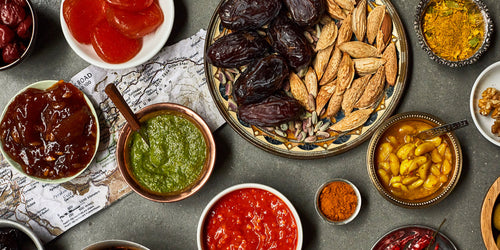Your Cart is Empty
Is there anything dal can’t do? Dal is frugal. Dal is also luxurious. It’s easy to make yet tastes like you cooked it all day. It’s good for our bodies and our souls, packed with fiber and comfort in equal measure. In most cases, dal doesn’t need to soak before simmering. It’s a hero of harried weeknights and lunches the morning after. If you don’t eat a lot of dal, consider a change.
Dal is the Hindi word for pulse, an amorphous term that encapsulates dried beans, lentils, and dried peas—about anything you’d call a legume. In practice, dal most often refers to both lentils and dishes made from them. Some are brothy soups, others as rich as stew. And while simmered pulses are a staple from the eastern Mediterranean through the Middle East and Central and South Asia, India is the undisputed Land of Dals. Stroll through the dry goods section of an Indian grocery and you’ll usually encounter over a dozen varieties in a rainbow of colors, but few instructions about how to treat each one.
All dals cook more or less the same way, but differences in shape, flavor, and starch composition will affect how they cook in your pot. Some dals melt away into buttery softness; others retain a distinct meaty chew. A few are more commonly used as a seasoning base as well as a cooking ingredient. So it pays to have a guide. Here’s a cheat sheet of some essential Indian dals worth knowing about—and how to cook them.
All dal’d up
Masoor dal
While you sometimes see it with brown hulls still attached, most masoor dal is sold without the hull, revealing a tiny brilliant orange lentil. In the absence of that hull, these tiny legumes more or less dissolve with prolonged cooking, subsuming their essence into a rich, creamy soup. The longer you cook them, the more they disintegrate, and the more buttery body you’ll give your dal. Flavor-wise, masoor dal brings a mild ruddy earthiness to the pot, so you’ll likely want to spice it up with some cumin, chile, and good ghee or olive oil, like in this red dal recipe. Shop masoor dal.
Moong dal
These are skinned and split yellow mung beans, and since they’re small and lack that outer hull like masoor dal, moong dal cooks quickly and tends to dissolve with prolonged cooking. But when cooked for shorter periods of time, it holds its shape a little better than masoor dal, adding a slight feathery texture and mild buttery flavor. Whether you’re cooking moong or masoor dal, one common step is to finish the dish with a tarka: a seasoned oil you drizzle over the dish just before serving. Heat a couple tablespoons of oil or ghee in a pan on medium-high heat along with a pinch of black mustard seeds. When the seeds start to pop, add a pinch of cumin seeds and some fresh sliced green chile, and toss them to coat in the oil. As soon as you smell cumin in the air and the chile skins turn glossy, dump the oil and spices into your pot of dal. Tarkas add a fragrant top note of spice that’s lost with prolonged cooking, and that final teensy bit of oil adds a luxuriousness to the bowl. Shop moong dal.
Moong beans
Here’s where Indian dal starts to get complicated. Mung beans, as they’re usually transliterated, are whole (that is, not split), hull-on legumes, and behave entirely differently from split and skinned moong dal—even though they’re basically the same lentil. While moong dal melts away in the pot, mung beans retain their shape even when cooked to complete softness, so they play well in saucy curries with vegetables or other larger legumes. They also taste a little vegetal and beany compared to buttery moong dal. Beyond simmering for soup, you can soak mung beans overnight, then grind them in a food processor with water, onions, garlic, ginger, and spices to make a thick batter for a savory pancake called pesarattu. It’s similar to a dosa, replacing that dish’s fermented twang with mung beans’ grassy essence. You can also sprout mung beans before cooking to make them more digestible. Shop mung beans.
Toor dal
Also called arhar dal or yellow pigeon peas, toor dal is thicker and rounder than its waifish masoor and moong cousins, so while you don’t need to soak it before cooking, a brief half-hour soak will speed things along. It’s one of the classic dal-as-soup dals along with masoor and moong, though it holds its shape better than either and has a more mealy texture that’s really nice with vegetables like spinach, string beans, tomatoes, and hearty greens. Shop toor dal.
Urad dal
These tiny skinned and split lentils are one half of the magic behind dosas. Dry urad dal is ground into a paste with rice and water, then left to naturally ferment before ladling into a hot buttered pan to cook into a paper-thin pancake. But urad dal also has another use entirely, critical to South Indian cooking. At the start of a bean or vegetable dish, a spoonful of dry urad dal often gets added to hot fat along with mustard seeds and other spices. The lentils toast and darken, adding a subtle nutty vibe to the pot. You might not notice the difference at first, but urad dal is a lot like bay leaves. It harmonizes everything else while bringing the dish’s flavor into focus. Don’t leave home without it. Shop urad dal.
Whole urad dal
Just like mung beans and moong dal, whole urad dal is a different thing all its own. You can also find split versions that still have their black hulls on, but whole urad dal is the most common. Think of it as the black bean of the dal world: distinct in flavor and texture with a dark richness that other legumes lack. (It also has a habit of darkening whatever broth it’s cooked in.) Whole urad dal retains its shape even after hours in the pot, and is the lentil of choice for dal makhani, literally buttered lentils, the cream- and ghee-enriched pride of Punjab. The key to great dal makhani is to cook it slowly over low heat, to ensure the lentils and kidney beans stay intact, and to layer in classic North Indian flavors like onion, garlic, ginger, cumin, and coriander. Oh, and lots of cream and butter. The dish just isn’t makhani without ‘em. Shop whole urad dal.
Chana dal
This is the split and skinned version of the chickpea, and in practice it behaves a lot like yellow and green split peas. You can simmer chana dal into a chunky stew that retains some of its bite, like toor dal, and add it to braised vegetables such as collard greens or kale for extra body and protein. In South Indian kitchens, chana dal often gets used as a seasoning just like urad dal, sometimes together sometimes on its own. The larger legume adds texture as well as toasty flavor, since it doesn’t dissolve completely, and brings a subtly different kind of deep roasted umph to a dish. Toasted chana dal is a great addition to bitter vegetables like broccoli rabe and bitter melon, especially when cut with a squeeze of lemon. Shop chana dal.
Chickpeas
Aka chana and chole, the legume loved around the world. Chana masala, a tomato-inflected spiced chickpea dish, is one of India’s most popular exports. In Punjab, a similar dish goes by the name chole (the Punjabi word for chickpea), and is typically made with roasted spices and without tomato. Chickpeas come in a wide range of sizes, which is handy for customizing in different dishes. If you plan to puree your chickpeas, get the skinned variety; it’ll make for a smoother mash. Shop chickpeas.
Black chickpeas
Also called kala chana or kadala, these are a relative of the common chickpea with a personality all their own. They’re small and dense, with a firm, chewy bite and robust earthiness. You’d never puree these beans; rather, they’re ideal for dishes that need a distinct beany presence and meaty flavor. In the southern state of Kerala, they’re often cooked into kadala curry, a rich sauce of shredded coconut, tomato, onion, and spices, to be served with idli or appam. Since they retain their shape so well, black chickpeas are also a great choice for bean salads and chaat. Shop black chickpeas.
Put your lentils to work
Recipe: Red Lentil Dal
Recipe: Curried Coconut Lentils
Recipe: Khara Huggi













